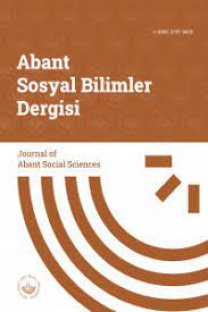ANTRENÖR DAVRANIŞI ALGISINDA CİNSİYETİN ETKİSİ
Bu çalışmanın amacı, sporcuların antrenör davranışı algılarında cinsiyetin etkisinin araştırılmasıdır. Çalışmanın örneklem grubunu, bireysel ve takım sporları yapan 120 erkek ve 85 kadın olmak üzere toplam 205 sporcudan oluşmuştur. Araştırma verileri, Üzüm ve Ark. (2018) tarafından geliştirilmiş 24 madde ve 3 alt boyuttan (karakter Özellikleri, Bilgi ve Beceri Birikimi, Adalet) oluşan “Algılanan Antrenör Tutum ve Davranışları Ölçeği” (AATDÖ) vasıtasıyla toplanmıştır. Verilerin analizi için Mann Whitney U-testi ve Spearman Korelasyon testi uygulanmıştır. Çalışmanın anlamlılık düzeyi p<0,05 olarak kabul edilmiştir. Araştırma sonucuna göre cinsiyet üzerinde en etkili antrenör davranışları “Karakteristik Özellikler” boyutuna ilişkin olanlardır.
Anahtar Kelimeler:
Sporcu, Antrenör Davranışı, Cinsiyet
___
- Alfermann, D., Lee, M. J., ve Würth, S. (2005). Perceived Leadership Behavior And Motivational Climate As Antecedents of Adolescent Athletes’ Skill Development. Athletic Insight, 7(2), 14-36.
- Ateş, C., Yıldız, Y., ve Yıldız, K. (2018). Profesyonel Basketbol ve Voleybolcuların Antrenör İletişim Beceri Düzeyleri Algısı ve Sporcuların Kaygı Düzeylerinin Araştırılması. Erciyes İletişim Dergisi, 5 (3), 40-52. DOI: 10.17680/erciyesakademia.331618
- Bebetsos, E., Filippou, F., ve Bebetsos, G. (2017). Athletes′ Criticism of Coaching Behavior: Differences Among Gender, And Type of Sport. Polish Psychological Bulletin, 48(1), 66-71.
- Carron, A.V., ve Bennett, B.B. (1977). Compatibility in The Coach–Athlete Dyad. Research Quarterly. American Alliance for Health, Physical Education and Recreation, 48, 671–679.
- Chelladurai, P., ve Saleh, S.D. (1980). Dimensions of Leader Behavior in Sports: Development of A Leadership Scale. Journal of Sport Psychology, 2, 34–45.
- Jowett, S., ve Ntoumanis, N. (2004). The Coach–Athlete Relationship Questionnaire (CART‐Q): Development and Initial Validation. Scandinavian journal of medicine & science in sports14.4: 245-257.
- Jowett, S., Shanmugam, V., ve Caccoulis, S. (2012). Collective Efficacy As A Mediator of The Association Between Interpersonal Relationships and Athlete Satisfaction in Team Sports. International Journal of Sport and Exercise Psychology, 10(1), 66-78.
- Koh, K. T., ve Wang, C. K. J. (2015). Gender and Type of Sport Differences on Perceived Coaching Behaviours, Achievement Goal Orientations and Life Aspirations of Youth Olympic Games Singaporean Athletes. International Journal of Sport and Exercise Psychology, 13(2), 91-103.
- Lafrenière, M. A. K., Jowett, S., Vallerand, R. J., ve Carbonneau, N. (2011). Passion for Coaching and The Quality of The Coach–Athlete Relationship: The Mediating Role of Coaching Behaviors. Psychology of Sport and Exercise, 12(2), 144-152.
- Mageau, G. A., ve Vallerand, R. J. (2003). The Coacheathlete Relationship: A Motivational Model. Journal of Sports Sciences, 21, 883-904.
- Murray, P., Rhiannon, L., ve Lorimer, R. (2018). The Influence of Gender on Perceptions of Coaches’ Relationships With Their Athletes: A Novel Video-Based Methodology. The sport journal.
- Navarre, M. J. (2011). Male College Soccer Coaches Perceptions of Gender Similarities and Differences İn Coach–Athlete and Teammate Relationships: Introducing The Construct of Relationship–Performance Orientation, A Dissertation Submitted To The Faculty of The Graduate School of The University of Minnesota, By In Partial Fulfillment of The Requirements For The Degree of Doctor of Philosophy.
- Poczwardowski, A., Barott, J. E., ve Henschen, K. P. (2002). The Athlete And Coach: Their Relationship and Its Meaning. Results of An Interpretive Study. International Journal of Sport Psychology, 33, 116-140.
- Sharma, R. (2015). Preferred Leadership Behaviours of Male and Female Badminton Players. International Journal of Science Culture and Sport (IntJSCS), 3(2), 73-83.
- Siekanska, M., Blecharz, J., ve Wojtowicz, A. (2013). The Athlete's Perception of Coaches’ Behavior Towards Competitors With A Different Sports Level. Journal of human kinetics, 39(1), 231-242.
- Smith, R.E., Smoll, F.L., ve Curtis, B. (1978). Coaching Behaviors in Little League Baseball. In F.L. Smoll and R.E. Smith (Eds.), Psychological Perspectives in Youth Sports. Washington, DC: Hemisphere, (pp. 173–201).
- Soyer, F., Sarı, İ., ve Talaghir, L. G. (2014). The Relationship Between Perceived Coaching Behaviour and Achievement Motivation: A Research in Football Players. Procedia-Social and Behavioral Sciences, 152, 421-425.
- Unutmaz, V., ve Gençer, T. (2017). Antrenör Yeterlilik Ölçeği II'nin Türkçe Uyarlama Çalışması”, Spor Bilimleri Araştırmaları Dergisi, 2(2), 69-78.
- Üzüm, H., Karlı, Ü., ve Yıldız, N. O. (2018). Perceived Coach Attitudes and Behaviors Scale: Development and Validation Study. Journal of Education and Training Studies, 6(3), 160-169.
- Wachsmuth, S., Jowett, S., ve Harwood, C. G. (2018). Managing Conflict in Coach—Athlete Relationships. Sport, Exercise, and Performance Psychology, 7(4), 371-391.
- Wylleman, P. (2000). Interpersonal Relationships in Sport: Unchartered Territory in Sport Psychology Research. International Journal of Sport Psychology, 31, 555–572.
- Yang, S. X., Jowett, S., ve Chan, D. K. C. (2015). Effects of Big‐Five Personality Traits on The Quality of Relationship And Satisfaction in Chinese Coach–Athlete Dyads. Scandinavian Journal of Medicine & Science in Sports, 25(4), 568-580.
- Yayın Aralığı: Yılda 3 Sayı
- Başlangıç: 2000
- Yayıncı: Abant İzzet Baysal Üniversitesi Sosyal Bilimler Enstitüsü
Sayıdaki Diğer Makaleler
ANTRENÖR DAVRANIŞI ALGISINDA CİNSİYETİN ETKİSİ
SÜRDÜRÜLEBİLİR TURİZM KAPSAMINDA FAALİYET GÖSTEREN SİVİL TOPLUM KURULUŞLARI ÜZERİNE BİR İNCELEME
YAŞAM DOYUMUNUN İŞ DOYUMUNA ETKİSİNDE SOSYAL ZEKANIN ARACI ROLÜ
İSTANBUL’DA “KADINA ŞİDDET” VE “KADIN CİNAYETİ” VAKALARINA YÖNELİK, NİCEL-NİTEL BİR İNCELEME
BİLARDO TOPUNUN YAPISININ SÖKÜMÜ: DIŞ POLİTİKA ANALİZİ
Dilek KOCABAŞ, Erdal EKE, Muazez DEMİR
ASİMETRİK VE SİMETRİK DÜNYA GÖRÜŞLERİNİN KURUMLARIN HALKLA İLİŞKİLER UYGULAMALARI ÜZERİNE ETKİLERİ
